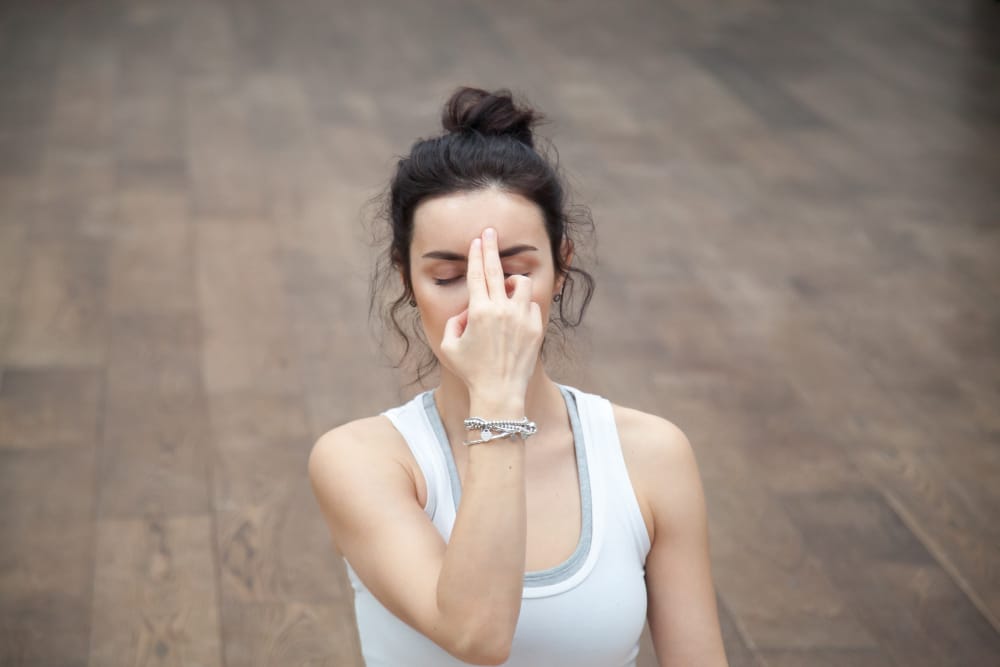Chest pain is a common thing felt by someone suffering from costochondritis or anxiety. But tips to calm down in each situation differ. Tips for calming costochondritis include practicing targeted stretches, using a hot or cold compress, including anti-inflammatory food, herbs, or supplements, minimizing pain, and trying TENS therapy. For anxiety, tips such as cutting down on caffeine, regular exercising, practicing yoga, listening to music, mediation, using visual techniques, practicing diaphragmatic breathing, and avoiding procrastination can be helpful. Consult a doctor before making any lifestyle changes that might affect your health.
When emotions overpower a person, it causes issues like anxiety attacks, of which discomfort or pain in the chest is one symptom. This discomfort pain in the chest is common with costochondritis, but physical factors are more responsible in this case.
In both cases, people experience discomfort in their chest, and it can tighten to the point that they don’t know what to do about it. Experiencing any pain in your chest can be terrifying.
So how do you relieve this chest pain? There’re plenty of tips to calm down when someone suffers from costochondritis or anxiety. Let’s take a look.
Costochondritis causing chest pain
Before jumping into tips to calm oneself down, let’s look at how costochondritis is causing chest pain in the first place.
Our ribs are connected to the breastbone by tough, protective tissue called cartilage. When this cartilage becomes inflamed, the condition is known as costochondritis or chest wall pain, and pain in the chest and breastbone is the main symptom that can even mimic a heart attack.
Causes of costochondritis
The causes are mostly unknown, but some things which can trigger it are:
- History or an illness that causes a lot of coughing
- Heavy lifting or strenuous exercise involving the upper extremities and chest wall
- Carrying heavy bags, such as a heavy backpack one side or the other
- Having large breasts
- History of chest injuries or chest infections
- Undergoing surgery that affects the chest wall, such as cardiac bypass
Symptoms of costochondritis
Chest discomfort or pain is the main symptom that can feel like burning, stabbing, or aching in nature. The most affected ribs include the second to fifth ones. Pain can be felt mostly left side of the body but can occur on both sides.
Things that can worsen the situation include coughing excessively, strenuous activities, or workouts. If you see swelling, it could be a variation called Tietze syndrome.
Tips for calming costochondritis
Costochondritis is manageable by following a few tips at home, which can help reduce the pain and prevent it from happening again. You can refer to a doctor and seek help from them, but you can instill a few things in your lifestyle.
1. Practicing stretches

When it comes to costochondritis, you will be advised not to put any pressure on your chest by indulging in strenuous activities or exercises, but a few stretches can help immensely. Targeted stretches can help improve the pain with costochondritis.
These exercises include stretching the arms, thorax, back, and chest muscles. Don’t force yourself too much and just enough each day to help the affected area.
Some exercises you can do:
Wall side stretch: Stand with your back against the wall. Raise your arms so that your fingertips point to the ceiling and your elbows are raised about shoulder height. Keeping your arms against the wall, raise them overhead. Hold and then lower to the start position. Repeat 10 to 12 times per session.
Scapula squeeze: Stand straight and tall, reaching your head toward the ceiling and breathing comfortably. Squeeze your shoulder blades together and hold the squeeze as long as it feels comfortable. Release. Repeat five to 10 times per session.
Stretch the pecs: Stand outside a doorway and reach your arms up as high as you can on either side of the frame. Supporting your weight with your hands, push your chest and body straight forward. Keep your abs tight so that your back doesn’t wobble or arch. Hold for a few seconds and return to the starting position. Repeat five to 10 times per session.
Thorax stretch: Sit down with your legs straight out in front of you, keeping your back straight. Now, with your hands on the floor at the side of your thighs, lean forward slowly. Curve down over your legs to move your belly button toward your spine. Hold for a few seconds and slowly sit back up. Repeat five to 10 times per session.
Side stretch: Seated in the same position as you did for the thorax stretch, except place your hands on your lower thighs. Bend your right arm and lean forward. Try to get your right elbow down to the knee on that side, allowing your hand to slide across your left leg. For an extra stretch, hold your elbow on the inside of the right knee, using the pressure between them to turn your chest further toward the left. Slowly release and return to the start position. Repeat this with the left side of the body. Alternate sides stretch each side 10 to 12 times per session.
2. Using hot or cold compress
Costochondritis pain and inflammation can be helped by using a hot or cold compress for the affected area. But don’t use such compresses for more than 15 minutes at a time.
Please don’t use the compress directly but wrap it in a cloth, then use it.
3. Anti-inflammatory foods, herbs, or supplements
Inflammation goes hand in hand with pain for someone suffering from costochondritis. Although doctors recommend certain medications to reduce inflammation, there’re other natural ways to reduce it.
- Focus on a diet rich in vegetables and fruits. Good options include berries, grapes, green leafy vegetables, tomatoes, pineapple, bok choy, cherries, avocadoes, broccoli, peppers, mushrooms, and beets.
- Get plenty of healthy fats via walnuts, fatty fish, olive oil, or coconut oil.
- Include chia seeds and ground flaxseeds, cocoa, or dark chocolate into your diet.
- Season foods with bone broth, turmeric, and ginger to boost extra anti-inflammatory.
- Drink green tea regularly.
- Certain herbs or supplements such as turmeric, glucosamine, ginger, ginseng, and many more can reduce inflammation and pain.
One needs to be aware that some of these can interact with NSAIDs, steroids, diabetes drugs, and other medications. So, consult with your doctor about what you can include and what not.
4. Reduce pain
Costochondritis is a painful chest wall condition caused by localized inflammation in the joints of the rib cage. Pain can be generated for various reasons, but specific steps can be taken to reduce this pain and not suffer so much.
Options include:
- Get treated for underlying infections such as pneumonia, chronic coughing, tuberculosis, respiratory disorders, or postoperative infections.
- Avoid getting exposed to allergens or things that irritate you.
- Rest as much as possible and avoid heavy lifting or physical activity.
- Take care of certain positions, sleep on the stomach, sing, and do activities.
- Some home remedies to try to include drinking plenty of water, sipping on bone broth or ginger tea, having a spoonful of honey, using a humidifier, taking vitamin C.
5. Transcutaneous electrical nerve stimulation (TENS)
TENS can be an effective pain relief method for some suffering from costochondritis. Under this therapy, a small device sends a weak electrical current to interrupt or mask the pain signals your body sends to your brain. It sends the signal through sticky patches on your skin near the painful area.
Some people find TENS therapy beneficial for pain and help relax their muscles. There’s a chance that this therapy also helps boost your production of endorphins which help diminish pain naturally.
Anxiety causing chest pain
Someone suffering from anxiety might show up in different ways, and sometimes those around them don’t even know they’re suffering from it. Chest pain is a physical symptom of a person suffering from an anxiety attack which is an apparent sign but differs from person to person.
This chest pain can feel different for each person. Some might feel it every day gradually, or others might feel it rarely but excruciating pain. It can be described as:
- Sharp, shooting pain
- Persistent chest aching
- An unusual muscle cramp or spasm in your chest
- Burning, numbness, or a dull ache
- Stabbing pressure
- Chest tension or tightness
Anxiety chest pain is possible because the body and brain respond when one becomes anxious. This includes a physiological change, and your body may tighten up or grow tense.
The chest pain can occur because many other emotions might be triggered when you become aggressive or upset more easily when you’re anxious. Your body prepares for a fight or flight response, and when you experience it frequently, your body doesn’t have enough time to recover.
This leads to muscle tension, which can create pain in the chest. Your heart rate may increase, and the forces of your heartbeats can grow stronger. Combined with tight chest muscles, that can make you feel unusual pain.
Tips to calm down anxiety
Suffering from anxiety attacks can lead to discomfort in your chest and cause severe pain other than several other issues in your health. One doesn’t and shouldn’t have to go through chest pain or other difficulties. So, there might be some ways or tips to minimize the attacks.
1. Drink less caffeine

Drinking coffee can energize you, and while that’s good for someone not suffering from anxiety, it can be a poor choice for someone suffering from anxiety.
Caffeine spikes your adrenaline levels, making a person suffering from anxiety even more anxious and creating a sort of panic in them. But coffee isn’t the only thing with caffeine in it, and there’re several other beverages or food items that contain caffeine.
Cutting out caffeine can minimize your anxiety attacks quite significantly. But if you’re already addicted to coffee, try leaving it slowly, not altogether be done with it, as it can cause withdrawal symptoms that have their downfalls you wouldn’t want to experience.
2. Exercise
Exercising can help you in a lot of ways. For anxiety, it can help you destress and elevate your mood. It’s also something to focus on, and so this way, you won’t have intrusive thoughts.
Including exercise in your lifestyle and other treatments of anxiety-like medications or therapy can help change anxiety attacks by reducing them significantly.
3. Yoga
Yoga is supposed to work your muscles while helping you calm down. It’s not a rigorous form of exercise for your body, and neither do you need to be in the company of others to do it.
Yoga has positive effects on your nervous system and mood, and it helps decrease heart rate, blood pressure, and cortisol levels. Many yoga poses are done by taking a deep breath which helps one calm down.
Cortisol is a big culprit for anxiety attacks as this hormone is involved in flight or fight response. Too much cortisol can exacerbate anxiety, and yoga is also helpful for people suffering from depression.
4. Listen to music
Music holds great power in uplifting one’s mood or calming someone down. Music is a language on its own, which even helps people sleep and complete their tasks successfully throughout the day. Right music at the right time can help you in any way possible.
It increases feelings of pleasure and alleviates stress and anxiety. You can depend on your favorite music or listen to some soft and soothing tunes to help you calm down.
5. Practice meditation

Meditation, just like yoga, can help your mind relax from all the thinking and useless thoughts creating a stir in your mind.
Deep breathing exercises and focus helps sort things out, feelings, bodily sensations and make you aware of yourself and things around you.
It might be difficult initially, but you can increase the meditation time with regular practice.
6. Use visualization techniques
Guided imagery is another type of meditation, and it’s where you mentally visualize peaceful scenes to promote a state of relaxation. This involves imagining any scene that evokes a sense of peace in your mind that can distract you from your anxious state and allow your mind and body to focus on the positive thoughts and sensations of the imagery exercise.
7. Practice diaphragmatic breathing
Relaxation strategies such as deep diaphragmatic breathing can lower your blood pressure, slow heart rate, and reduce the tension commonly associated with stress. You can do it for 10 minutes each day to relieve anxiety:
- Lie flat on the back with the knees bent and the soles of the feet on the floor.
- Place one hand on the upper chest and the other on the stomach, below the ribcage.
- Breathe slowly and deeply in through the nose. Draw the breath down toward the stomach so that the hand on the stomach rises upward. Make sure that the hand on the chest stays still.
- Exhale slowly through pursued lips, drawing the belly button down toward the floor. The hand on the stomach should return to its original position, and the hand on the chest should remain still.
8. Avoid procrastination
Those suffering from anxiety tend to procrastinate too, which is more problematic than it might seem. As you rush to be done with the work at the last moment, it creates more anxiety and stress for you. There’s a need to learn time management which can prevent procrastination.
9. Therapy
Various therapies can give you much-needed relief and an outlet to let all these emotions out in a safe and professional space without feeling judged. The therapists are there to help you in any way possible by making you come to various realizations and help you work out your issues.
- Counseling is a short-term therapy option that lasts several weeks. The therapist is there to help you develop strategies for managing stressful situations.
- Psychotherapy tends to be a long-term therapy that may cover a broader range of mental health issues.
- Cognitive-behavioral therapy helps people recognize how negative thought patterns can influence their mood and behavior. CBT helps people replace these negative thoughts and habits with positive and constructive ones. Over time it can help reduce your anxiety.
FAQs
What helps anxiety and costochondritis?
When people suffer from anxiety or costochondritis, one thing in common is feeling discomfort in the chest or severe pain. Those with panic disorder often report shortness of breath and chest pain as symptoms.
Some relaxation techniques that can help include progressive muscle relaxation, exercise, breathing exercises, massage, yoga, and acupuncture, reducing stress, anxiety, costochondritis, and pain suffered due to it.
Can anxiety cause costochondritis?
Costochondritis can be aggravated by any activity that stresses your chest, such as strenuous exercise or even simple movements like reaching up to a high cupboard. But chest pain due to anxiety is caused because of emotional stress.
There’s a clear difference between these two. Although there’s no scientific research to back this claim, they might influence each other. So to treat either of these issues, different approaches are suggested.
Why do I have anxiety for no reason?
Anxiety can be caused due to various reasons, some pretty prominent and others not so much. Sometimes you don’t even know a thing could be secretly developing anxiety issues in you until you suffer from one of the symptoms of anxiety.
Some causes include stress, genetics, brain chemistry, traumatic events, or environmental factors. Not just medication or therapy is needed, but a change in one’s lifestyle is much required to get through anxiety and minimize it as much as possible or reduce its impact gradually.
Why does my anxiety get worse at night?
Due to various reasons, your anxiety can get unbearable to handle, especially at night, such as daily stressors, poor sleep habits, and other health conditions can lead to such condition. It’s even worse at night than during the day because you don’t have anywhere to be at night, and it’s just you, your thoughts, and your bed.
It’s best to develop a healthy nighttime routine that can help you long-term. Some things to include are exercising daily, setting a sleep schedule, avoiding stimulants before bed, turning off electronics, creating a comfortable environment.
Does costochondritis get worse at night?
Pain or discomfort in the chest can be felt more intense at night than during the day. It’s better to find a suitable sleeping position to help reduce the pain as much as possible. Try not to sleep on the side affected, back, or stomach.
While sleeping on the other side, which isn’t affected, prop up your ribs with a pillow to give it support during the night.
To summarize
Costochondritis and anxiety are two separate issues but have one common similarity: discomfort in your chest or even pain. While chest pain can signify someone suffering from anxiety, costochondritis is caused when someone feels pain in their chest.
There might be a relation between costochondritis and anxiety though there’s no scientific proof. But one might influence others and ultimately cause you discomfort. The tips to calm down in both these issues are different.
Other than medications and therapy, it’s best to make some lifestyle changes and use some home remedies like targeted stretching for costochondritis and a good exercise routine to help recover from anxiety episodes.
Whichever situation you’re suffering from, I hope these tips help you prevent further discomfort.


